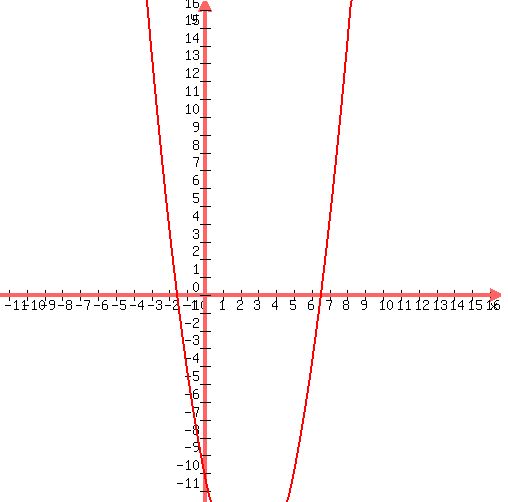Question 86122: Find the axis of symmetry...
1. y=-x^2+4x+2
2. y=x^2+x+1
Find the x-intercepts...
1.y=x^2+2x-8
2. y=x^2-5x-10
Answer by jim_thompson5910(35256)   (Show Source): (Show Source):
You can put this solution on YOUR website! 1.
| Solved by pluggable solver: Completing the Square to Get a Quadratic into Vertex Form |
 Start with the given equation Start with the given equation
 Subtract Subtract  from both sides from both sides
 Factor out the leading coefficient Factor out the leading coefficient 
Take half of the x coefficient  to get to get  (ie (ie  ). ).
Now square  to get to get  (ie (ie  ) )
 Now add and subtract this value inside the parenthesis. Doing both the addition and subtraction of Now add and subtract this value inside the parenthesis. Doing both the addition and subtraction of  does not change the equation does not change the equation
 Now factor Now factor  to get to get 
 Distribute Distribute
 Multiply Multiply
 Now add Now add  to both sides to isolate y to both sides to isolate y
 Combine like terms Combine like terms
Now the quadratic is in vertex form  where where  , ,  , and , and  . Remember (h,k) is the vertex and "a" is the stretch/compression factor. . Remember (h,k) is the vertex and "a" is the stretch/compression factor.
Check:
Notice if we graph the original equation  we get: we get:
 Graph of Graph of  . Notice how the vertex is ( . Notice how the vertex is ( , , ). ).
Notice if we graph the final equation  we get: we get:
 Graph of Graph of  . Notice how the vertex is also ( . Notice how the vertex is also ( , , ). ).
So if these two equations were graphed on the same coordinate plane, one would overlap another perfectly. So this visually verifies our answer.
|
2.
| Solved by pluggable solver: Completing the Square to Get a Quadratic into Vertex Form |
 Start with the given equation Start with the given equation
 Subtract Subtract  from both sides from both sides
 Factor out the leading coefficient Factor out the leading coefficient 
Take half of the x coefficient  to get to get  (ie (ie  ). ).
Now square  to get to get  (ie (ie  ) )
 Now add and subtract this value inside the parenthesis. Doing both the addition and subtraction of Now add and subtract this value inside the parenthesis. Doing both the addition and subtraction of  does not change the equation does not change the equation
 Now factor Now factor  to get to get 
 Distribute Distribute
 Multiply Multiply
 Now add Now add  to both sides to isolate y to both sides to isolate y
 Combine like terms Combine like terms
Now the quadratic is in vertex form  where where  , ,  , and , and  . Remember (h,k) is the vertex and "a" is the stretch/compression factor. . Remember (h,k) is the vertex and "a" is the stretch/compression factor.
Check:
Notice if we graph the original equation  we get: we get:
 Graph of Graph of  . Notice how the vertex is ( . Notice how the vertex is ( , , ). ).
Notice if we graph the final equation  we get: we get:
 Graph of Graph of  . Notice how the vertex is also ( . Notice how the vertex is also ( , , ). ).
So if these two equations were graphed on the same coordinate plane, one would overlap another perfectly. So this visually verifies our answer.
|
We can find the x-intercepts by the quadratic formula
1.
Starting with the general quadratic

the general form of the quadratic equation is:

So lets solve 
 Plug in a=1, b=2, and c=-8 Plug in a=1, b=2, and c=-8
 Square 2 to get 4 Square 2 to get 4
 Multiply Multiply  to get to get 
 Combine like terms in the radicand (everything under the square root) Combine like terms in the radicand (everything under the square root)
 Simplify the square root Simplify the square root
 Multiply 2 and 1 to get 2 Multiply 2 and 1 to get 2
So now the expression breaks down into two parts
 or or 
Lets look at the first part:
 Add the terms in the numerator Add the terms in the numerator
 Divide Divide
So one answer is

Now lets look at the second part:
 Subtract the terms in the numerator Subtract the terms in the numerator
 Divide Divide
So another answer is

So our solutions are:
 or or 
Notice when we graph  we get: we get:

and we can see that the roots are  and and  . This verifies our answer . This verifies our answer
2.
Starting with the general quadratic

the general form of the quadratic equation is:

So lets solve 
 Plug in a=1, b=-5, and c=-10 Plug in a=1, b=-5, and c=-10
 Square -5 to get 25 Square -5 to get 25
 Multiply Multiply  to get to get 
 Combine like terms in the radicand (everything under the square root) Combine like terms in the radicand (everything under the square root)
 Simplify the square root Simplify the square root
 Multiply 2 and 1 to get 2 Multiply 2 and 1 to get 2
So now the expression breaks down into two parts
 or or 
Which approximate to
 or or 
So our solutions are:
 or or 
Notice when we graph  we get: we get:

when we use the root finder feature on our calculator, we find that  and and  .So this verifies our answer .So this verifies our answer
|
|
|